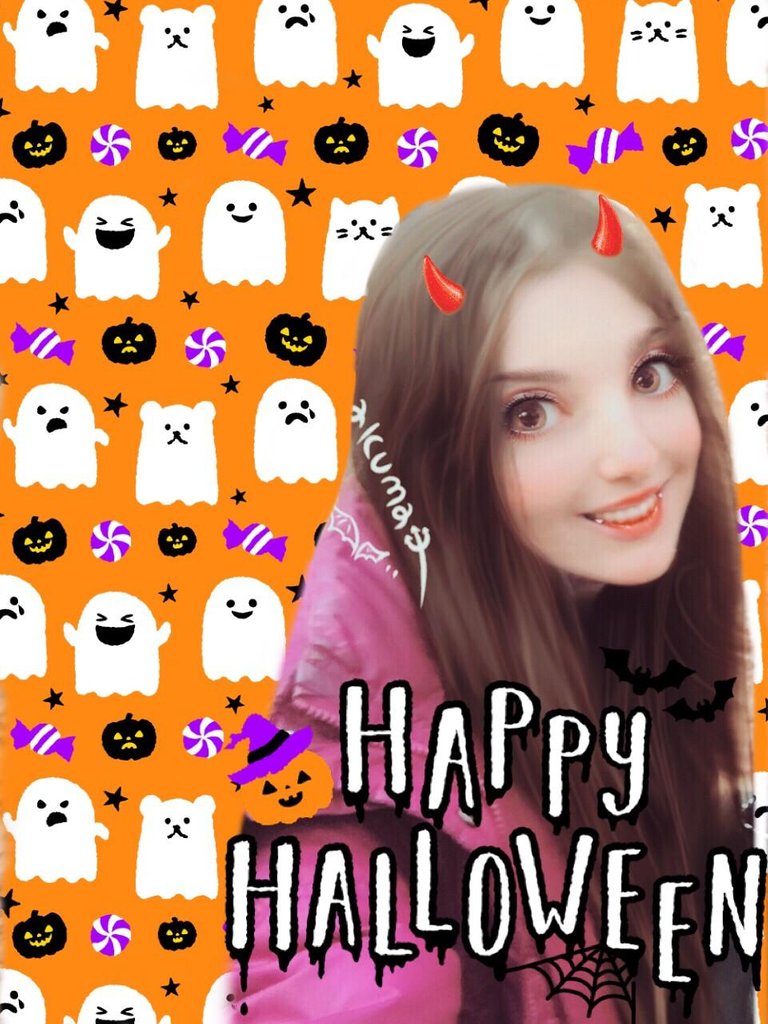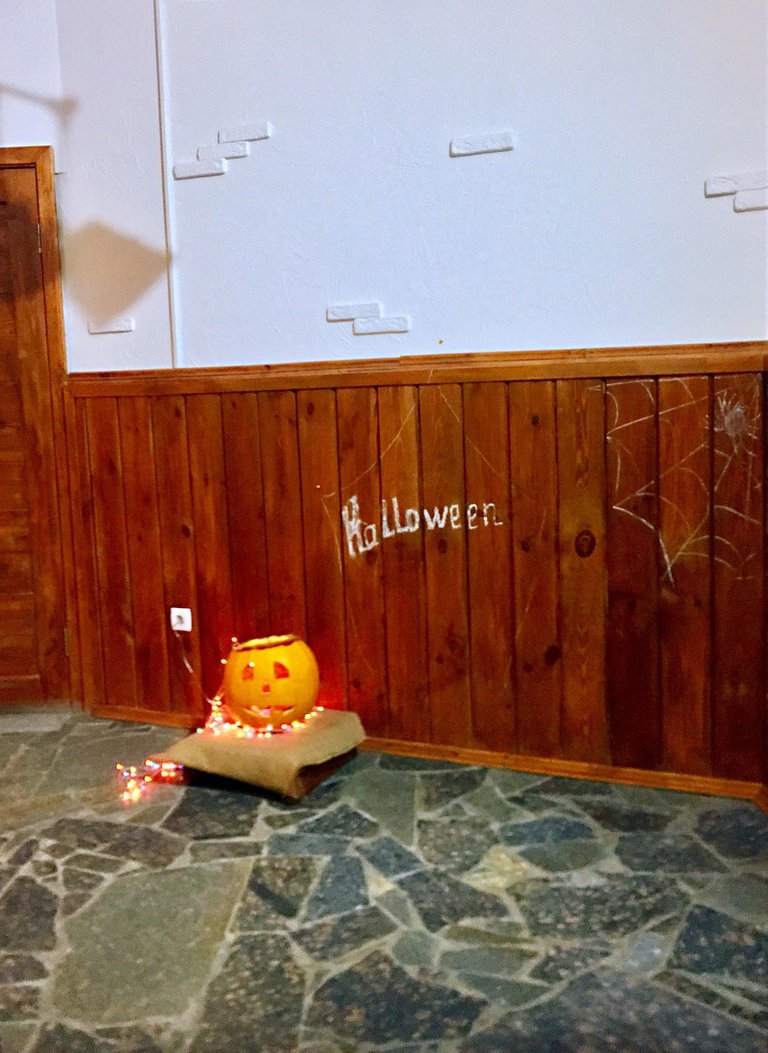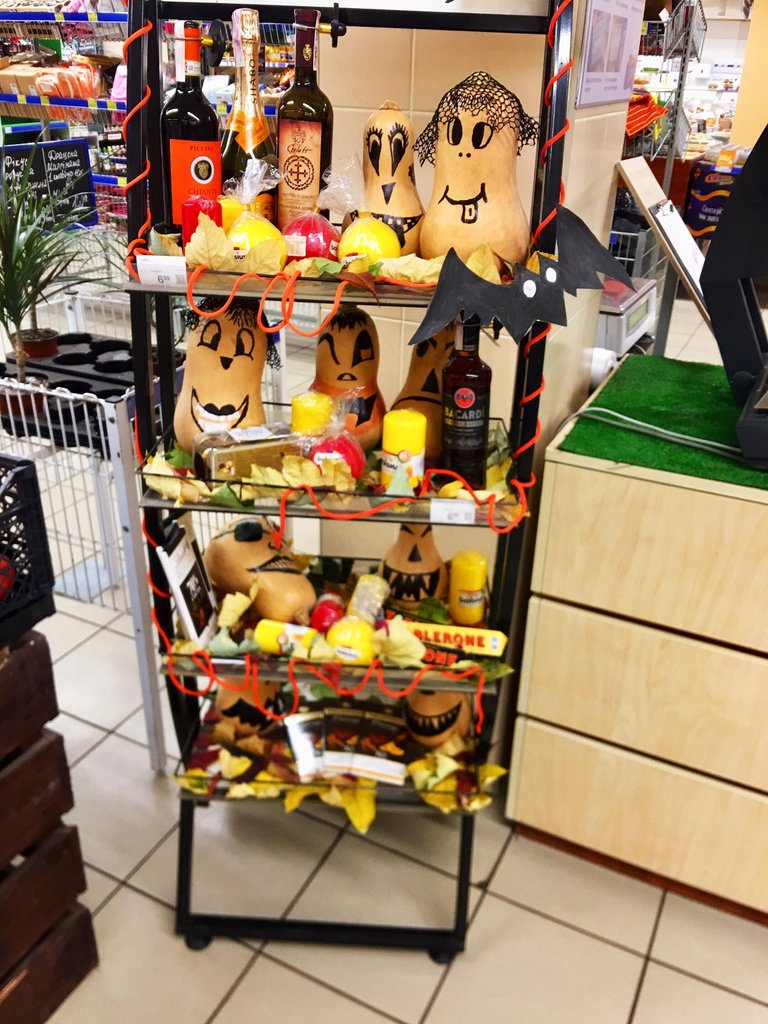
HI, STEEMIT 😊
This holiday came to Ukraine not so long ago, at the end of the 20th century. Halloween is not among the official holidays of Ukraine, but despite this, it has become popular among Ukrainian youth and many people celebrate on the night of October 31 to November 1 :)
Halloween comes from the old Celtic harvest festival and the day of the dead. It all started with an innocent November 1, which the ancient Celts chose for a special celebration - Samhayna (the day of honoring the ancestors and something like the New Year). It was the day when the first snow fell on the ground, winter came to replace summer, and the Celts gathered the harvest. It is not surprising that in such a terrible time, it was believed that the dead are returning to earth to visit living relatives.
It was not only the Celts who believed that the souls of the dead could visit the living. Slavs (especially Ukrainians and Belarusians) periodically performed rituals called "Grandfathers", "Baba" and "Children" to commemorate their deceased relatives. On the appropriate days, people went to the graves of relatives and honored them, bringing hot memorial dishes (it was believed that the spirits could inhale the smell of this food). And during family meals, additional tableware for guests from the other world appeared on the table. Separately mentioned the name of each ancestor.
For centuries, the Christmas decoration of the Ukrainian table was diduh, which symbolized not only the harvest and welfare, but also the ancestor, the initiator and guardian of the clan, that is, had a direct bearing on the aforementioned rite. In fact, this symbol is not Christian, it has pagan roots. Our ancestors believed that it was the spirit of all the forefathers of the family. When Christianity appeared, such rituals did not disappear, but changed somewhat, so it is difficult to trace which traditions were pagan and which were added over time.
And even Christians now have a similar memorable day when all the dead are honored.
The Day of the Dead is celebrated in Mexico and in some Spanish-speaking countries just on November 1-2. This is a pretty amazing holiday. After all, he seems to be associated with the Catholic Day of All Saints, but altars built in honor of the dead are decorated with figures of skulls (albeit rather cute, made of sugar). It would seem that this is not very Christian. But for some reason they are forgiven. Those who celebrate this holiday believe that it is on this day that the souls of the dead visit their living relatives, therefore the living go to the cemetery with their favorite dishes and drinks "guests from the otherworldly".
All Saints' Day is a Christian holiday, when believers venerate all church saints. Celebrated on November 1 and is considered one of the most important. The date was chosen because of the Celtic Samhain. The first who began to celebrate the Day of All Saints, were the Irish and the British from whom Halloween happened. In Halloween, pagan traditions were embodied for which there was no place in a Christian holiday, for example, dressing and coaxing evil spirits with sweets.
And the Celts believed that on this day, in addition to the souls of the dead, various evil spirits could also come to the earth: house-spirits, demons, witches and other mischievous characters (who are also in Ukrainian ancient beliefs). Disguise was just an attempt to deceive evil spirits. People believed that the witches and the dead could kidnap their children, therefore, in order to confuse evil spirits, they dressed the kid in scary costumes. They also tried to pay off otherworldly forces by filling up a bag of goodies. Probably this was what little mischief-makers learned about and decided to take advantage of the situation in their favor;)
There are also disguises in Ukrainian culture. In winter, at Christmas or during Malanka, young people change their image. A disguised den goes and sings carols for Christmas. Although there is not much of a negative character besides the devil, there are also some Halloween dresses for princesses and animals.
With disguise and loud fun, the mini-carnival of Malanka takes place on the night of January 14, or on Old New Year. Usually, members of the den wear Cossacks, gypsies, animals and folk characters. The traditional characters are the "woman" Malanka and the "grandfather" Vasily. And modern characters have been added to them today. This tradition is also not very common in Ukraine, but at the winter carnival "Malania", what is happening in the Ternopil region, you can feel the real spirit of celebration.
It is believed that the name Halloween has a Christian foundation. At first they called this day Allhallowmas, (the mass of all Hallows - the mass of All Saints), and the evening before was called All Hallows Eve - the fore-evening of all saints. Over time, the name turned into Halloween.
The most famous Halloween symbol is Jack's Lamp - a pumpkin with a carved face and shining eyes.
I made these photos in supermarkets.



An interesting legend is associated with it - a blacksmith named Jack, an alcoholic and a miser, once lived in Ireland. But the guy was cunning and was able to twice deceive the devil and bargain for a few years of life for himself. And when his time came, Heaven did not accept Jack, and through a treaty with the Devil he could not go to hell either. His soul had to wander on earth. As a result, Jack received only 2 hot coals and put them in a pumpkin instead of a lantern. Perhaps this gift was given to him from Heaven so that he could scare the Devil. Or maybe it was the last gift from hell that should light his way in eternal darkness. Be that as it may, this flashlight as well as dressing up is like protection against evil spirits.
It's time to sum up. The Celts first began to celebrate this day. Christians tried to eradicate pagan customs, tried to replace one celebration with another. But people did not want to give up their ancient traditions despite all the attempts of the church. Although this is not the first time, after all, in the Ukrainian beliefs Christian traditions are closely intertwined with pagan rituals, which often cannot be separated from one another.
Most people are negatively perceived when something new and unknown leaks into their culture. But most people defend themselves by the fact that this is a devilish holiday. Well, maybe his roots are not Christian, but Ukrainian great-grandfathers also had their own gods. We may not perceive their views on life, but respect and honor them. So what is the difference between the ancestors of another nation?
On the other hand, it’s just one day in a year when people can afford to “go to the side of evil,” fool around and have fun. This does not mean that in their minds something will change and they will remain so forever, right?
It may be difficult for us to understand the motives for celebrating such a strange day from the point of view of Christianity. But this is also a part of world culture, traditions and customs of ancestors, world heritage. And what's wrong if, thanks to such holidays, children and young people can have fun. The main thing is to learn to perceive correctly and be able know when to stop;)
First of all, we must adhere to Ukrainian traditions, but other cultures must be respected, because we want to become part of the world community, to which we are so eager :) To do this, we still need to learn to accept other cultures without prejudice and superstition :)
🎃🎃🎃 Happy Halloween To You🎃🎃🎃
Check out my Halloween Scary Smoothie🕸🕷🎃
В Украину этот праздник пришел не так давно, в конце 20 века. Хеллоуин не входит в число официальных праздников Украины, но не смотря на это, он стал популярен среди украинской молодежи и много людей празднуют в ночь с 31 октября на 1 ноября :)
Хеллоуин произошёл от старого кельтского праздника жатвы и дня мертвых. Все началось с невинного 1 ноября, которое древние кельты выбрали для особого празднования – Самайна (день чествования предков и что-то вроде Нового года). Это был день, когда на землю падал первый снег, зима приходила на смену лета, а кельты собирали урожай. Неудивительно, что в такое жуткое время, считалось что мертвые возвращаются на землю чтобы посетить живых родственников.
Не только кельты верили в то, что души умерших могут посещать живых. Славяне (особенно украинцы и белорусы) периодически совершали обряды под названием "Деды", "Бабы" и "Дети" для поминовения умерших родственников. В соответствующие дни люди шли на могилы родных и чествовали их, принося горячие поминальные блюда (считалось, что духи могли вдыхать запах этой пищи). А во время семейных трапез на столе появлялись дополнительные столовые предметы для гостей из потустороннего мира. Отдельно упоминалось имя каждого предка.
Испокон веков рождественским украшением украинского стола был дидух, который символизировал не только урожай и благосостояние, но и предка, зачинателя и оберега рода, то есть имел прямое отношение к вышеупомянутому обряду. На самом деле этот символ не является христианским, он имеет языческие корни. Наши предки верили, что это дух всех дедов-предшественников рода. Когда появилось христианство, такие обряды не исчезли, но несколько изменились, поэтому трудно проследить, какие традиции были языческими, а какие добавились со временем.
И даже христиане сейчас имеют похожий памятный день, когда почитаются все умершие.
День мертвых празднуют в Мексике и в некоторых испаноязычных странах как раз 1-2 ноября. Это довольно удивительный праздник. Ведь он вроде связан с католическим Днем всех святых, но алтари, построенные в честь умерших, украшают фигурками черепов (хотя и довольно милых, сделанных из сахара). Казалось бы, это не сильно по-христиански. Но им почему-то прощается. Те, кто отмечает этот праздник, верят, что именно в этот день души умерших посещают своих живых родственников, поэтому живые идут на кладбище с любимыми блюдами и напитками "гостей из потустороннего".
День всех святых - христианский праздник, когда верующие почитают всех церковных святых. Отмечается 1 ноября и считается одним из важнейших. Дата была выбрана из-за кельтского Самайна. Первыми кто начал праздновать день всех святых, были ирландцы и англичане от которых и пошел Хеллоуин. В Хеллоуине воплотились языческие традиции, для которых не было места в христианском празднике, например переодевание и задабривание нечистой силы сладостями.
А кельты считали, что в этот день кроме душ умерших на землю может попасть и разная нечисть: домовые, бесы, ведьмы и другие озорники (которые есть и в украинском древних верованиях). Маскировка была всего лишь попыткой обмануть злых духов. Люди верили в то, что ведьмы и мертвецы могут похитить их детей, поэтому чтобы сбить нечисть с толку переодевали малыша в страшные костюмы. Ещё пытались откупиться от потусторонних сил, насыпав сумку вкусностей. Наверное об этом и узнали маленькие озорники и решили в свою пользу воспользоваться ситуацией ;)
В украинской культуре есть и переодевания. Зимой на Рождество или во время Маланки молодежь меняет образ. Переодетый вертеп ходит и поет колядки на Рождество. Хоть кроме чертенка, отрицательных персонажей там не так много, но и на Хеллоуин некоторые одеваются принцессами и животными.
С переодеваниями и громкими забавами "мини-карнавал" Маланка происходит в ночь на 14 января, или на Старый Новый год. Обычно участники вертепа одеваются казаками, цыганятами, животными и фольклорными персонажами. Традиционными персонажами остаются "баба" Маланка и "дед" Василий. И современные персонажи добавились к ним сегодня. Эта традиция тоже не очень распространена в Украине, но на зимнем карнавале "Малания", что происходит в Тернопольской области вы можете почувствовать настоящий дух празднования.
Есть мнение, что название Хеллоуин имеет христианское основание. Сначала называли этот день Allhallowmas, (the mass of all Hallows - месса Всех святых), а вечер накануне назвали All Hallows Eve - предвечерье всех святых. Со временем название превратилось в Хеллоуин.
Самым известный символ Хеллоуина это Светильник Джека - тыква с вырезанным лицом и сияющими глазами. С ним связана интересная легенда, когда-то жил в Ирландии кузнец по имени Джек - алкоголик и скряга. Но парень был хитёр и смог дважды обмануть дьявола и выторговать несколько лет жизни для себя. А когда пришло его время, Небо не приняло Джека, а через договор с Дьяволом он не мог попасть в ад тоже. Его душе пришлось блуждать на земле. В итоге Джек получил только 2 раскаленные уголька и поместил в тыкву вместо фонаря. Возможно этот подарок дали ему Небеса, чтобы он мог отпугивать Дьявола. А может это был последний подарок из ада, который должен освещать ему путь в вечной тьме. Как бы то ни было, этот фонарик так же как и переодевания - как защиту от нечисти.
Пришло время подводить итоги. Кельты начали праздновать этот день первыми. Христиане пытались искоренить языческие обычаи, попытались заменить одно празднование другим. Но люди не захотели отказаться от своих древних традиций несмотря на все попытки церкви. Хотя это не первый случай, ведь и в украинских верованиях христианские традиции тесно переплелись с языческими обрядами что зачастую одно от другого отделить не могут.
Большинство людей негативно воспринимают когда в их культуру вдруг просачивается что-то новое и неизвестное. Но у большинство людей защищается тем, что это дьявольский праздник. Что же, возможно корни у него же и не христианское, но и у украинских прадедов тоже были свои боги. Мы можем не воспринимать их взгляды на жизнь, но уважаем и чтим их. Так чем же отличаются предки другого народа?
С другой стороны, это всего лишь один день в году, когда люди могут позволить себе "перейти на сторону зла" пошалить и повеселиться. Это не значит, что в их сознании что-то изменится и они останутся такими навсегда, правда же?
Возможно нам трудно понять мотивы празднования такого странного дня, с точки зрения христианства. Но это тоже часть всемирной культуры, традиции и обычаи предков, всемирного наследия. И что плохого, если благодаря таким праздникам дети и молодежь могут повеселиться. Главное научиться правильно воспринимать и вовремя уметь остановиться ;)
В первую очередь мы должны придерживаться украинских традиций, но нужно уважать и другие культуры, ведь мы хотим стать частью мирового сообщества, к которому так стремимся :) Для этого ещё нужно научиться принимать другие культуры без предрассудков и суеверий :)
🎃🎃🎃 Весёлого Вам Хеллоуина 🎃🎃🎃
Зацени мой Жуткий Хэллоуин Смузи🕸🕷🎃
и Хеллоуин тогда и сейчас 🎃
Thank you for reading up to this point 😊
Спасибо тебе за то, что дочитал до этого места 😊

I wish you all a sunny shining mood 😊
Eat more fruits 😊
Желаю вам всем солнечного сияющего настроения 😊
Ешьте больше фруктов 😊
I really appreciate your feedback: Upvote👍, Comments😎, Resteem😍, Subscribe🐾
Я очень ценю вашу обратную связь: Голоса👍, Комментарии😎, Репосты😍, Подписку🐾




Thanks for using eSteem!
Your post has been voted as a part of eSteem encouragement program. Keep up the good work! Install Android, iOS Mobile app or Windows, Mac, Linux Surfer app, if you haven't already!
Learn more: https://esteem.app
Join our discord: https://discord.gg/8eHupPq
Defended (20.00%)
Summoned by @inna-world
Sneaky Ninja supports @youarehope and @tarc with a percentage of all bids.
Everything You Need To Know About Sneaky Ninja
woosh
Congratulations @inna-world! You have received a personal award!
Click on the badge to view your Board of Honor.
Do not miss the last post from @steemitboard:
Хохлы должны жить в своей стране!!! И не лезть в нашу Европу!!!!
)))))кто это у тебя в комментах?
Немцы со шведами пришли в гости к хохлушкам!!!
Привет из Российской Федерации.
не знаю, но почерк одинаковый)
Freaking ghosty